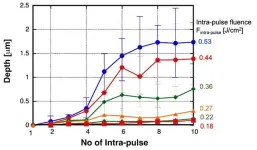(Press-News.org) BIRMINGHAM, Ala. — Common treatments for Parkinson’s disease can address short-term symptoms but can also cause extensive problems for patients in the long run. Namely, treatments can cause dyskinesia, a form of uncontrollable movements and postures.
In a recent study published in The Journal of Neuroscience, researchers at the University of Alabama at Birmingham took a different approach to dyskinesia and treated it like a “bad motor memory.” They found that blocking a protein called Activin A could halt dyskinesia symptoms and effectively erase the brain’s “bad memory” response to certain Parkinson’s treatments.
“Instead of looking for a completely alternative treatment, we wanted to see if there was a way to prevent dyskinesia from developing in the first place,” said David Figge, M.D., Ph.D., lead study author and assistant professor in the UAB Department of Pathology. “If dyskinesia does not occur, then patients could potentially stay on their Parkinson’s treatment for longer.”
Parkinson’s disease is a neurodegenerative disorder caused by the death of neurons that make dopamine. To counteract this loss, clinicians currently use L-DOPA, a drug that is a precursor to dopamine.
Short term, L-DOPA is helpful; but long term, it leads to L-DOPA-induced dyskinesia in some patients, which causes involuntary, erratic movements such as twitching, fidgeting, head-bobbing or body swaying. Even if a patient stops taking L-DOPA for a certain period, dyskinesia has proved to come back quickly — as soon as these patients restart treatment.
“It seemed like the brain was forming a motor memory, and each time a patient received L-DOPA treatment, this memory then recalled upon every subsequent L-DOPA exposure,” said Karen Jaunarajs, Ph.D., assistant professor in the UAB Department of Neurology.
Due to the overlaps between motor and behavioral memory, the team decided to approach dyskinesia like a bad memory. If they could find a way to cause the brain to forget its previous treatment history, they could potentially prolong the usefulness of L-DOPA for Parkinson’s treatment.
Researchers first studied the striatum, the brain region significant to motor control, to figure out which cells were storing the “bad motor memory.” The most significant changes observed were in neurons called D1-MSNs, which acted in a similar way to neurons in the hippocampus when it is forming a memory.
“We found that some of these D1-MSNs were expressing genes indicating that they were being activated by L-DOPA and genes that were necessary for creating new connections with other cells,” Figge said. “This was very similar to what happens when you learn something new and recall that memory.”
Researchers found that one gene in these L-DOPA-activated D1-MSN neurons is translated into a protein called Activin A. By blocking the function of Activin A, researchers were able to block the development of L-DOPA-induced dyskinesia in mouse models.
“In essence, by prohibiting the protein from functioning, we were able to halt the development of dyskinesia symptoms in the mouse models, effectively erasing the brain’s memory of the motor response to L-DOPA,” Jaunarajs said.
Ultimately, the hope is that these findings will lead to an understanding of how to block these bad motor memories altogether — eradicating dyskinesia-related symptoms in Parkinson’s patients.
The study was supported by the Parkinson’s Association of Alabama, the American Parkinson Disease Association and the United States Department of Defense.
END
Erasing “bad memories” to improve long term Parkinson’s disease treatment
2024-07-08
ELSE PRESS RELEASES FROM THIS DATE:
Restored oyster sanctuaries host more marine life
2024-07-08
In the campaign to restore Chesapeake Bay, oyster sanctuaries rank among the most hotly contested strategies. But new research suggests these no-harvest areas are working, and not only for the oysters. In a new study published July 4 in Marine Ecology Progress Series, Smithsonian biologists discovered oyster sanctuaries contain more abundant populations of oysters and other animal life—and the presence of two common parasites is not preventing that.
Oysters form the backbone of Chesapeake Bay. Besides injecting millions of dollars into the regional economy each year, they also act as vital habitat and filter feeders that clean the water. But their populations ...
Research spotlight: Machine learning helps identify patients at varying levels of risk for opioid use disorder
2024-07-08
Ronen Rozenblum, PhD, MPH, director of the Unit for Innovative Healthcare Practice & Technology and director of Business Development of the Center for Patient Safety Research and Practice at Brigham and Women's Hospital, and an assistant professor at Harvard Medical School, is the principal investigator and senior author of a new study published in JMIR Medical Informatics, “A Machine Learning Application to Classify Patients at Differing Levels of Risk of Opioid Use Disorder: Clinician Based ...
Detroit researchers receive Department of Defense grant to assist in discovering new treatments for ovarian cancer
2024-07-08
DETROIT — Gen Sheng Wu, Ph.D., professor of oncology in the Wayne State University School of Medicine and the Barbara Ann Karmanos Cancer Institute, recently received a grant from the U.S. Department of Defense’s Congressionally Directed Medical Research Programs.
This four-year, $924,000 grant will benefit Wu’s study, “Targeting Dual-Specificity Phosphatase 1 in Platinum Resistance in Ovarian Cancer,” which aims to discover improved treatments for ovarian cancer.
“Ovarian cancer ...
Acupuncture reduces methadone dose and opioid cravings in patients undergoing methadone maintenance therapy
2024-07-08
Embargoed for release until 5:00 p.m. ET on Monday 8 July 2024
Annals of Internal Medicine Tip Sheet
@Annalsofim
Below please find summaries of new articles that will be published in the next issue of Annals of Internal Medicine. The summaries are not intended to substitute for the full articles as a source of information. This information is under strict embargo and by taking it into possession, media representatives are committing to the terms of ...
Novel compound offers improved defense against fentanyl overdoses
2024-07-08
Scientists at the University of Florida have identified a novel compound aimed at improving the treatment of opioid overdoses, which claimed the lives of more than 81,000 Americans last year.
The discovery could combat the devastating epidemic of opioid-related deaths, driven predominantly by the proliferation of fentanyl. The highly potent synthetic opioid is a pain reliever and among the nation’s most abused substances.
“Fentanyl is driving the need to find better treatments for opioid overdoses,” said Jay McLaughlin, Ph.D., a professor of pharmacodynamics in the UF College of Pharmacy. “Every opioid death is preventable, highlighting ...
NIH awards Wake Forest University School of Medicine $27 million to study vascular health and its impact on cognition
2024-07-08
WINSTON-SALEM, N.C. – July 8, 2024 – Researchers at Wake Forest University School of Medicine have been awarded a five-year, $27 million grant from the National Institute on Aging (NIA), part of the National Institutes of Health (NIH), to renew funding for MESA-MIND, an ancillary study to the Multi-Ethnic Study of Atherosclerosis (MESA).
In 2018, researchers at Wake Forest University School of Medicine received more than $18 million from the NIA to launch MESA-MIND to study the connections between heart health and brain health.
“In MESA-MIND, we are studying how heart health contributes to brain health in diverse groups of people,” said Timothy Hughes, Ph.D., ...
College of Public Health receives NIH grant to pilot AI chatbot for African Americans with depression
2024-07-08
As a leader in innovative health solutions, George Mason University’s College of Public Health received a National Institutes of Health (NIH) AIM-AHEAD program grant to pilot an artificial intelligence (AI) chatbot for Black and African Americans with depression. Health Informatics Professor Farrokh Alemi will enhance his first-of-its-kind, evidence-based artificial intelligence tool to address the medication needs of African Americans with depression.
The existing AI tool recommends antidepressants for 16,775 general-population patient subgroups, each representing a unique combination of medical history. For each of ...
RCMAR Annual Meeting promotes mentorship and research on aging
2024-07-08
The latest Annual Meeting convened by the Resource Centers for Minority Aging Research (RCMAR) National Coordinating Center, held in Arlington, Virginia, from June 26 to 28, centered on the theme of transforming diverse aging research through inspiring and mentoring scientists.
Current and former RCMAR scientists presented research findings from completed pilot studies and progress updates for ongoing research. The meeting included several professional development sessions for the scientists and members of RCMAR ...
Exploring distress experiences of patients with sickle cell disease
2024-07-08
COLUMBUS, Ohio – While distress is well-documented in patients with sickle cell disease, sources of distress and how patients manage distress have not been well explored.
“Our study found that the most profound source of distress for patient with sickle cell disease in a home visit program was anticipating and going to acute care centers to manage their acute pain,” said senior study author Maryanna Klatt, PhD, director of the Center for Integrative Health at The Ohio State University Wexner Medical Center.
Study findings are published ...
Super-resolution machining of single crystalline sapphire by GHz burst mode femtosecond laser-induced plasma assisted ablation
2024-07-08
A new publication from Opto-Electronic Advances; DOI 10.29026/oea.2024.240029 , discusses super-resolution machining of single crystalline sapphire by GHz burst mode femtosecond laser-induced plasma assisted ablation.
GHz burst-mode femtosecond (fs) laser, which emits a series of pulse trains (burst pulse) with extremely short intervals of several hundred ps, offers distinct characteristics in materials processing as compared with conventional fs laser (single-pulse mode). The authors of this article have demonstrated that the GHz burst mode fs laser greatly improves ablation efficiency, quality and speed. GHz burst mode fs laser was further applied ...




